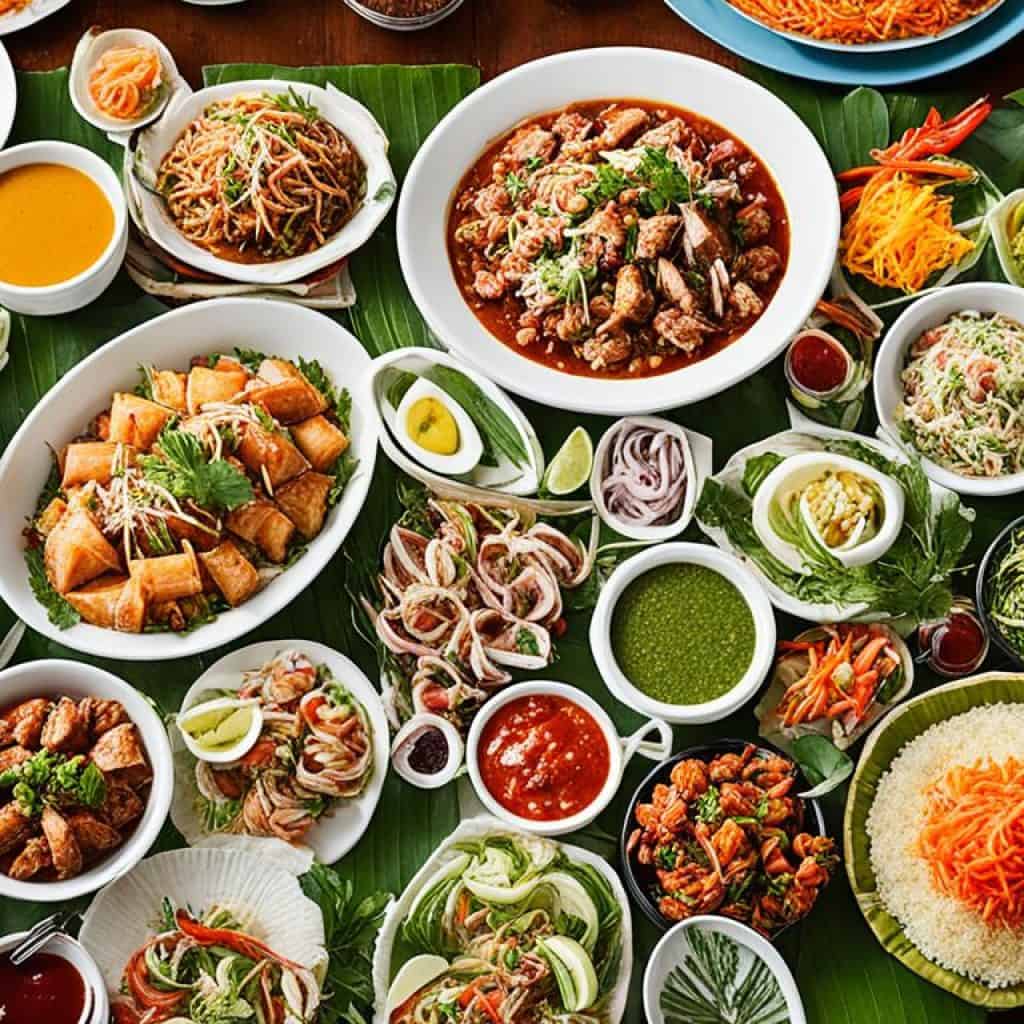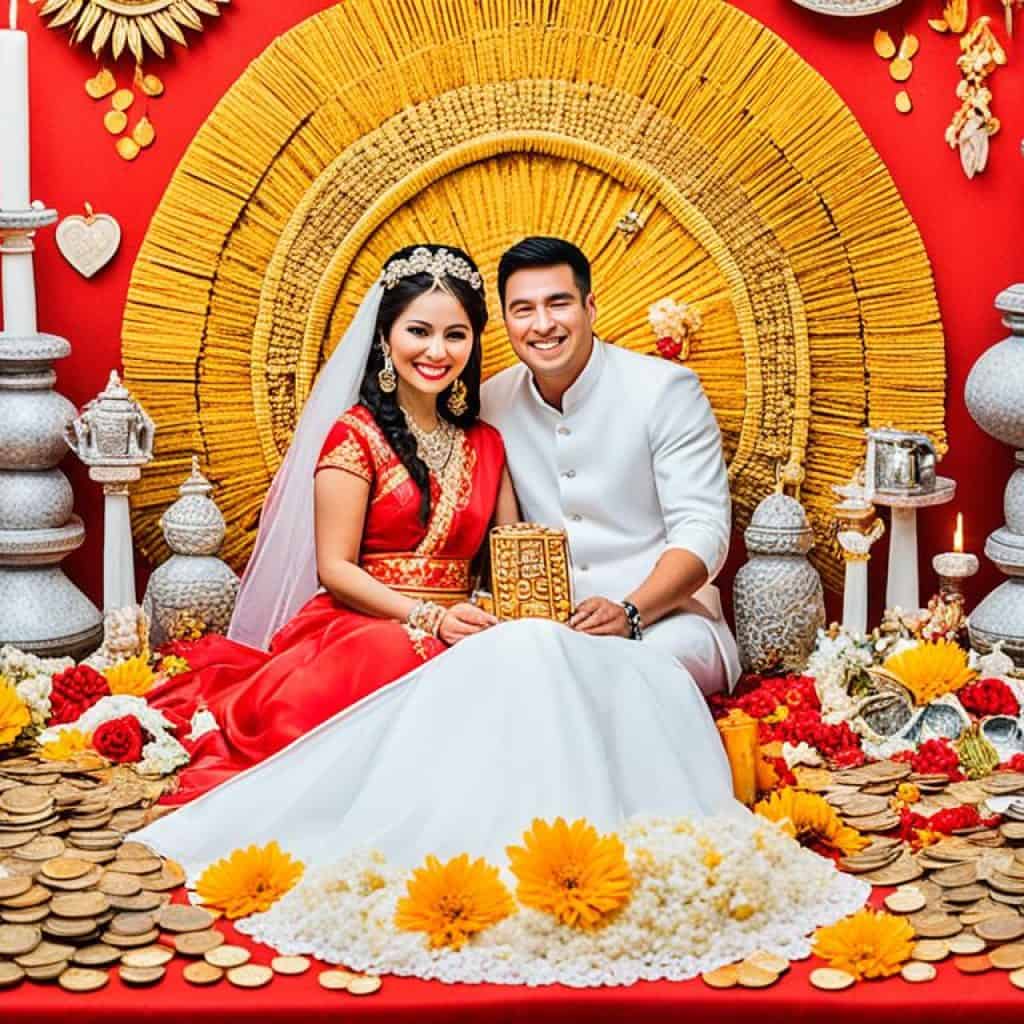Are you planning a Filipino wedding and curious about the various traditions and legal rules in the Philippines? You’re in the right place! This guide will show you the different types of marriage in the Philippines. It will give you ideas to make your wedding unforgettable and true to your Filipino heritage1.
Whether you’re thinking of a civil wedding, a religious ceremony, or a mix of faiths, this article has you covered. It talks about the marriage laws in the Philippines, legal marriages in the Philippines, marriage ceremonies in the Philippines, marriage traditions in the Philippines, marriage customs in the Philippines, marriage requirements in the Philippines, marriage processes in the Philippines, and the many marriage types in the Philippines you should know for your dream Filipino wedding2.
Key Takeaways
- Discover the diverse types of marriages recognized in the Philippines, from civil to religious and interfaith ceremonies.
- Learn about the legal requirements and processes for obtaining a marriage license and registering your wedding in the Philippines.
- Explore the rich cultural traditions and customs that shape Filipino weddings, from pre-wedding rituals to the reception celebration.
- Understand the significance of family involvement and community celebration in Filipino marriage traditions.
- Gain insights on how to personalize your Filipino wedding by blending modern and traditional elements.
Introduction to Filipino Marriage Traditions
Filipino wedding traditions blend many cultures, from indigenous to Spanish, American, Chinese, and Islamic influences3. The Pamamanhikan ceremony and the money dance at the reception show the importance of family, community, and preserving heritage4.
Overview of the Diverse Cultural Influences Shaping Filipino Weddings
The Philippines’ culture greatly influences its wedding traditions. About 80% of Filipinos are Catholic, so many weddings are in Catholic churches with Spanish touches4. But, the country’s mix of cultures means many weddings also include Muslim, Chinese, and other traditions4.
Importance of Preserving Cultural Heritage in Modern Weddings
When planning their weddings, Filipino couples aim to keep their cultural heritage alive. By adding traditional elements, they make sure these customs last for future generations. This way, they celebrate and keep their Filipino identity strong.4
“Filipino weddings mix old and new, showing the value of family and meaningful rituals.”4
Traditions like the Pamamanhikan, Barong Tagalog, and folk dances are key to modern Filipino weddings. Keeping these customs alive honors heritage and keeps Filipino culture vibrant4.
Pre-Wedding Traditions and Customs
The engagement ceremony, known as Kasunduan, is a big step towards marriage for Filipino couples. It’s where the couple exchanges rings, just like in the West5.
The Pamamanhikan: Formal Engagement Ceremony
The Pamamanhikan is the first big step. The groom-to-be visits the bride’s family to ask for their blessing5. It’s important for all couples, including LGBTQ+ ones, to bring both families together in celebration5.
Kagen & Taltag: Muslim Filipino Engagement Rituals
In Mindanao, Muslim Filipino couples have the Kagen & Taltag ceremony. They give a dowry to the bride’s family and do a spiritual cleansing called palamas6.
Ting Hun: Chinese-Filipino Engagement Ceremony
For Filipino-Chinese couples, the Ting Hun is key. Families exchange gifts like fruits and red envelopes with money, showing they accept the union6.
“The engagement ceremony is a time-honored tradition that brings together families, celebrating the couple’s commitment and paving the way for a meaningful wedding celebration.”
These traditions, influenced by different cultures, prepare for the wedding celebrations. By keeping these customs, Filipino couples make their wedding unique and special567.
Wedding Venue and Decor
Filipino couples often look for wedding venues that reflect their culture. Many choose traditional churches, but modern weddings are going for unique spots8. Young couples want their weddings to be fun and full of experience, not just formal8. They’re picking places other than churches for their big day8.
Adding traditional touches to the decor is a big part of honoring Filipino culture8. Vendors and planners use tropical flowers and traditional materials for decor8. Using banig mats, local flowers, and brass accessories shows pride in heritage and supports local artisans.
Choosing a Venue that Reflects Cultural Heritage
Today’s Filipino weddings mix modern and traditional to show the couple’s style8. Places like creative studios and redwood amphitheaters are popular for receptions8. Choosing a venue that honors their roots makes the day special and memorable.
Incorporating Traditional Elements in Wedding Decor
Adding Filipino traditions to the decor is a lovely way to celebrate heritage8. Modern takes on traditional clothes, like Barong Tagalog and Filipiniana gowns, are in style for weddings8. Fusion foods at receptions add a new twist to old favorites8. Interactive food stations, like Halo Halo Bars, are becoming a hit at Filipino weddings8. Sweet Condesa Pastries combines traditional flavors with modern looks for desserts8. Using family recipes and Titas for dessert bars is a new trend8.
“Preserving cultural heritage while embracing modern trends is the key to creating a truly unique and memorable Filipino wedding experience.”
Selecting Sponsors and Wedding Entourage
Choosing ninongs and ninangs (wedding sponsors) is key in a traditional Filipino wedding. They are legal witnesses and help with the ceremony9. Filipino weddings usually have main and secondary sponsors. The main sponsors sign the marriage certificate and help with the ceremony9. Secondary sponsors, often close friends or family, assist with rituals like the candle, cord, and veil ceremonies9.
The number of sponsors can change, and they might share duties. For example, two sponsors might do both the cord and the veil9. Older, experienced couples are often chosen as sponsors, showing the value of wisdom in Filipino culture9. When picking sponsors, couples think about the values they want to show and choose people who share those values9.
The Role of Ninongs and Ninangs (Godparents)
Ninongs and ninangs, or godparents, are very important in Filipino weddings. They stand for the values the couple wants to follow9. To be a principal sponsor in the Philippines, you must be 18 or older, and you need at least two to sign the marriage contract10. Traditional Filipino weddings also have six secondary sponsors for the cord, veil, and candle ceremonies, with two for each10.
Now, Best Men and Groomsmen have new roles. Best Men carry the wedding rings and give a speech, while Groomsmen help with wedding tasks and escort guests10. Maid/Matron of Honor assists the bride, like choosing outfits and organizing events10.
While Filipino weddings stick to tradition, couples can make changes to fit their style9. Choosing sponsors is a big deal, as couples look for people who share their values and can offer guidance9.
Traditional Filipino Wedding Attire
When it comes to Filipino wedding fashion, the traditional attire for the groom and bride is very important. The barong tagalog, a sheer, embroidered long-sleeve shirt, is key for Filipino grooms11. This shirt dates back to before the Spanish came and is still a big part of Filipino fashion, worn for big events like weddings and baptisms11. Now, more women are wearing the barong tagalog, showing a change in who wears this traditional outfit11.
The Filipiniana dress is a beloved choice for brides. These dresses have different styles, like the terno and traje de mestiza, with big puffy sleeves and lots of embroidery11. Some brides might pick a Western-style wedding dress, but wearing Filipiniana is a great way to celebrate their culture on their wedding day11. Couples can buy these dresses or have them made just for them, and add Filipino-style jewelry like gold filigree earrings and brass bracelets11.
The Amerikana, a suit with a jacket, vest, tie, and trousers, is also popular for Filipino grooms because of American influence in the Philippines11. Back in the 1920s, it was worn by students and city folks, and now it’s often seen at Filipino weddings11.
Guests at Filipino weddings can show respect for the couple’s culture by wearing Filipino-made jewelry like necklaces, bracelets, cufflinks, and clutches11. Traditional items like the pamaypay or abaniko can help keep cool during the ceremony11. But, it’s important for guests to be careful not to copy Filipino culture wrongly. They should choose items made by Filipino artists, not sacred symbols or patterns11.
“Creative accessory options include cufflinks handcrafted in the pre-colonial art form called gold filigree, providing a unique touch to wedding attire.”11
By choosing traditional Filipino wedding clothes and accessories, couples and guests can celebrate the rich culture that makes Filipino weddings special11.
Wedding Ceremony Rituals and Symbolism
Filipino weddings are filled with deep cultural traditions. Each ritual and symbol has a special meaning. The candle lighting and coin exchange show the importance of family, unity, and prosperity in Filipino weddings.
The Candle Ceremony
The candle lighting is a key moment in a Filipino wedding. Ninong and ninang (godparents) light the couple’s candles and a third one together. This symbolizes the couple’s commitment and shared faith12.
The Unity Cord and Veil Ceremony
The unity cord and veil ceremony is another important part of Filipino weddings. The couple wears a veil, showing their humility and God’s guidance12. Two sponsors tie them with a yugal, a silk lasso, symbolizing their unity12. These ceremonies highlight the strong bond of love and God’s protection in their marriage.
The Arras (Coin) Ceremony
The 13 coins, or arras, are a big part of Filipino weddings. The groom gives these coins to the bride, promising to support her financially12. This tradition comes from Catholic roots and shows the couple’s promise to help each other in marriage.
These rituals and symbols are more than just pretty; they carry deep cultural and spiritual meaning121314. By keeping these traditions alive, couples make their wedding meaningful and true to their heritage. This sets a strong foundation for a life of love and commitment.
Indigenous and Ethnic Wedding Traditions
The Philippines is a mix of many cultures, each with its own wedding traditions4. About 80% of Filipinos are Catholic, making Catholic wedding traditions common15. But, the country has over 100 indigenous groups, each with their own wedding customs.
In some tribes, parents arrange marriages, not the couple themselves15. These weddings often include animal sacrifices for god’s blessing15. The bride’s family also gets gifts, and the celebrations can last for days15.
The variety of wedding customs in the Philippines is amazing16. Tribes like the Bontoc or Igorot, Manobo, Tausug, T’boli, Maranao, and Badjao have their own ways15. For example, the Igorot tribe has ceremonies that last for days, with food exchanges between families15. The Manobo tribe has dowry talks and feasts to show the couple’s duties to each other15. The Tausug tribe does arranged marriages with Islamic ceremonies led by an Imam15.
When weddings mix religions, both faiths’ traditions are used in the ceremony15. Today, tribal weddings in the Philippines mix old and new customs, happening in different places15.
The mix of indigenous and ethnic wedding traditions shows the Philippines’ rich culture and strength16. Even with Western and modern influences, Filipinos keep their old customs alive. This way, their wedding traditions keep their heritage going.
The Reception: Handaan
The Handaan, or wedding reception, is a time for Filipino couples to share their culture’s rich food traditions. Dishes like lechon (roast pig), pancit (noodles), and sweets like sapin-sapin, ube, and bibingka make the banquet special17. To make sure guests have a great time, couples often hire catering experts for an authentic meal.
At Filipino weddings, the money dance is a big deal. Guests give money to the couple as they dance, or use digital ways to help them start their life together17. This fun event lets guests wish the couple well and support their marriage17.
“The money dance is a symbolic gesture that demonstrates the community’s commitment to supporting the couple’s new journey together.”
The money dance shows how much the community values helping each other out and being financially stable in Filipino weddings17. Over time, the tradition has changed, with couples now using digital ways to give money, keeping the spirit alive17.

The Handaan reception is full of life, from the traditional food to the money dance. It’s a celebration of the couple and the Philippines’ culture17. As weddings change, these old traditions keep making the celebration special17.
Blending Traditions in Modern Filipino Weddings
Modern Filipino weddings are a mix of old customs and new trends. Couples pick traditional parts to make their day special. They mix their family’s history with their own style and likes.
About 90% of Filipino weddings have pamamanhikan, where the groom’s family visits the bride’s to ask for her hand in marriage. This shows how important family is in these weddings18. Also, over 95% of weddings use arras, which are coins that symbolize the couple’s money matters and commitment to each other18.
Some couples stick to old ways, but many add their own touches like personal vows and ring exchanges. These modern touches are in 70% of weddings now18. Around 30% of weddings feature traditional clothes from different regions, showing the variety in Filipino culture18.
Destination weddings are getting popular, with about 25% of them happening in unique places. This shows how couples want a special and personal day18. Young couples, making up 60%, like mixing old and new in their weddings18.
By choosing certain traditions, Filipino couples make their weddings meaningful and true to their roots. They might wear traditional clothes, follow old rituals, or add their own special touches. This way, modern Filipino weddings mix old and new, celebrating the past and the present181920.
“The beauty of modern Filipino weddings lies in the couple’s ability to thoughtfully select the customs and traditions that resonate most with them, creating a celebration that is a true expression of their shared heritage and personal journey.”
types of marriage in philippines
In the Philippines, couples have many choices for their big day. The top choices are civil weddings and religious or interfaith weddings21. Knowing about these options helps you pick a wedding that fits your beliefs and culture.
Civil Weddings in the Philippines
A civil wedding is a legal ceremony done by a government official. It’s a simpler and cheaper choice than religious weddings, perfect for those watching their budget or not tied to a faith21. To get married civilly in the Philippines, you need IDs, a birth certificate, a no-marriage certificate, and a marriage license form. Prices vary from free to PHP 8,000, based on where and when you’re getting married22.
Religious and Interfaith Weddings
Many Filipino couples still prefer religious or interfaith ceremonies21. Catholic-Christian weddings are popular, often featuring the candle, cord, and veil ceremonies22. Couples from different faiths might pick a ceremony that mixes traditions from both, making it special to them23.
It’s key to plan well for any wedding, booking services like caterers, florists, photographers, and venues early. This ensures your day goes smoothly and is unforgettable22.
“The diversity of marriage traditions in the Philippines reflects the country’s rich cultural heritage and the adaptability of its people to modern times.”
Family Involvement and Community Celebration
Filipino weddings are more than just a union of two people. They celebrate family and community. The Pamamanhikan, a traditional engagement ceremony, shows the importance of family in marriage decisions24.
The bayanihan, a custom of family and community helping with wedding prep, is less common now24. Yet, the spirit of community support is still key in Filipino weddings. Modern couples often choose family members as sponsors and honor elders during the wedding24.
Asking parents for their blessing before and during the wedding is a common tradition24. This shows respect and the family’s big role in the couple’s journey. Traditional attire like the Barong Tagalog and María Clara gown also highlight cultural heritage and family legacy24.
The community’s role doesn’t end with the ceremony. The Arras or 13 coins and the money dance at the reception show community support24.
The Family Code of the Philippines shows the country’s strong family and community values25. Today, couples blend tradition with personal choices, keeping family and community at the wedding’s core.
Filipino Wedding Superstitions and Beliefs
Filipino weddings are filled with old superstitions and beliefs. These traditions come from both before and after the time of Spanish rule. They show how important marriage is in Filipino culture26.
One old superstition is that the bride shouldn’t try on her wedding dress before the wedding. This is thought to bring bad luck27. Also, it’s unlucky for siblings to get married in the same year, a belief known as “sukob.”2728
Symbolic items and rituals are key in Filipino wedding customs. The unity candle must stay lit during the ceremony, or it could mean a sad future27. If the wedding ring, veil, or “arrhae” (coins) are dropped, it’s seen as a sign of trouble in marriage27.
Superstitions also play a big part on the wedding day. Couples might pick their date and time carefully to avoid bad luck. If a bride is menstruating on her wedding day, it’s seen as a sign of a big family to come27. Rain on the wedding day is thought to mean good luck and a happy marriage27.
- Before Spanish rule, it was common for the groom or bride to stay close to home before the wedding to avoid accidents26.
- It was believed that brides shouldn’t wear pearls, as they symbolized tears, to prevent bad luck26.
- The tradition of men carrying bolos and musicians playing agongs was done to keep away bad luck, showing the importance of rituals26.
- Breaking plates during the reception was done to chase away bad luck, highlighting a unique custom26.
These superstitions and beliefs, influenced by both indigenous and colonial traditions, still affect Filipino weddings today2628. Keeping these customs alive lets couples honor their heritage and have a meaningful, fun celebration28.

“The more food at the reception, the more bountiful the blessings the marriage will receive.”27
| Superstition | Belief |
|---|---|
| Never clear the table while somebody is still eating | The person will never get married |
| Brides shouldn’t try on her wedding dress before the wedding day | The wedding will not push through |
| Giving an arinola (chamberpot) as a wedding gift | Brings good luck to the giver and the newlyweds |
| A downpour during the wedding | Brings prosperity and marital bliss |
Planning a Meaningful Filipino Wedding
Planning your Filipino wedding lets you add personal touches that show your love story and heritage29. Filipinos love big family gatherings for weddings, showing the importance of inviting many guests29. By choosing special elements, you make your wedding a true reflection of your values and identity.
Personalizing Cultural Traditions
Filipino weddings are full of customs with deep meanings29. When planning, think about adding the candle, cord, and veil rites, which are key parts of a Filipino ceremony29. These traditions can be made your own, making your wedding a meaningful celebration of your heritage.
Choosing your wedding clothes is another way to make your day special29. Many couples wear traditional Filipino outfits, like the Barong Tagalog or Filipiniana dress, to honor their roots29. You can mix classic styles with your own taste for a unique look.
Creating New Customs
Today, Filipino weddings are evolving, and many couples add new customs that fit their style and stories29. Including Filipino food is a big part of a traditional wedding, showing the value of local cuisine29. You might also use technology, like a digital guestbook or social media photo booth, for a modern touch.
By making your Filipino wedding personal, it will truly reflect your heritage and who you are29. Wedding planners offer help with cultural traditions, showing there’s a big need for expert advice29. Whether you update old customs or start new ones, your wedding will be a memorable celebration of your love and roots.
Conclusion
As you’ve learned, Filipino weddings blend many cultural traditions. They show the mix of influences on the Philippines over the years. Monogamy is key and30 attitudes towards living together and other choices have changed. The Philippines has seen big changes in marriage31 over a hundred years.
Planning your Filipino wedding lets you pick meaningful customs and start new ones. This way, your wedding reflects your heritage and your future together. It’s a chance to make your special day truly yours.
Even without a divorce law, many couples end their marriages legally or informally. This shows how views on different ways of living together are changing31. As you start this new chapter, celebrate your Filipino roots in a way that feels real and important to you.
FAQ
What are the different types of marriage in the Philippines?
What are the legal requirements for getting married in the Philippines?
What are some of the traditional Filipino wedding ceremonies and customs?
How can couples incorporate Filipino cultural elements into their wedding decor and attire?
What is the role of sponsors (Ninongs and Ninangs) in a Filipino wedding?
What are some of the unique Filipino wedding reception traditions?
How are Filipino weddings evolving to reflect modern sensibilities?
Source Links
- https://culturalatlas.sbs.com.au/filipino-culture/filipino-culture-family
- https://psahelpline.ph/blogs/distinguishing-between-cenomar-and-advisory-on-marriage
- https://www.courtly.com/resources/how-to-get-married-online-in-the-philippines-step-by-step-guide
- https://www.linandjirsa.com/filipino-wedding-traditions/
- https://en.wikipedia.org/wiki/Marriage_and_wedding_customs_in_the_Philippines
- https://www.filipinowedding.com/pages/filipino-wedding-traditions
- https://www.theknot.com/content/cultural-traditions-philippines
- https://www.filipinowedding.com/blogs/wedding-blog/7-ways-to-take-your-filipino-wedding-reception-from-formal-to-fun-family-party
- https://www.filipinowedding.com/blogs/wedding-blog/how-to-choose-filipino-wedding-sponsors-ask-yourself-these-3-important-questions
- https://www.nuptials.ph/entourage-for-a-traditional-pinoy-wedding/
- https://www.filipinowedding.com/blogs/wedding-blog/what-to-wear-to-a-filipino-wedding-tips-to-crack-the-dress-code
- https://www.provenance.co/post/filipino-wedding-traditions-a-comprehensive-guide
- https://www.townsdelight.com/blog/10-popular-filipino-wedding-traditions
- https://weddedwonderland.com/15-filipino-wedding-traditions-you-wont-believe/
- https://www.nuptials.ph/tribal-wedding-philippines/
- https://barongworld.com/blogs/news/filipino-wedding-traditions-a-tapestry-of-culture-and-love
- https://www.filipinos2meet.com/blog/filipino-traditional-wedding/
- https://barongworld.com/blogs/news/the-rich-tapestry-of-philippine-marriage-culture-traditions-values-and-evolution
- https://the-smile-bar.ph/philippine-wedding-traditions-you-should-know/
- https://theamm.org/ceremony-scripts/167-modern-filipino-wedding-ceremony-script-with-unity-veil-cord-coins
- https://www.jojies.com/wedding-philippines-marriage-types/
- https://marryonchain.com/p/articles/everything-you-need-to-know-about-marriage-in-the-philippines
- https://factsanddetails.com/southeast-asia/Philippines/sub5_6c/entry-3872.html
- https://www.trulyfilipino.com/blog/eight-filipino-wedding-traditions-you-should-know/
- https://joeam.com/2014/04/04/the-family-code-insights-into-filipino-culture/
- https://zzanyy.blogspot.com/2015/03/filipino-wedding-superstitions.html
- https://weddingsatwork.com/philippine-wedding-folklore-superstitions/
- https://jardindemiramareventsvenue.com/filipino-wedding-traditions-and-superstitions/
- https://www.filipinowedding.com/blogs/wedding-blog/the-first-5-steps-to-plan-your-filipino-wedding
- https://factsanddetails.com/southeast-asia/Philippines/sub5_6c/entry-3870.html
- https://paa2006.populationassociation.org/papers/61021







Add comment